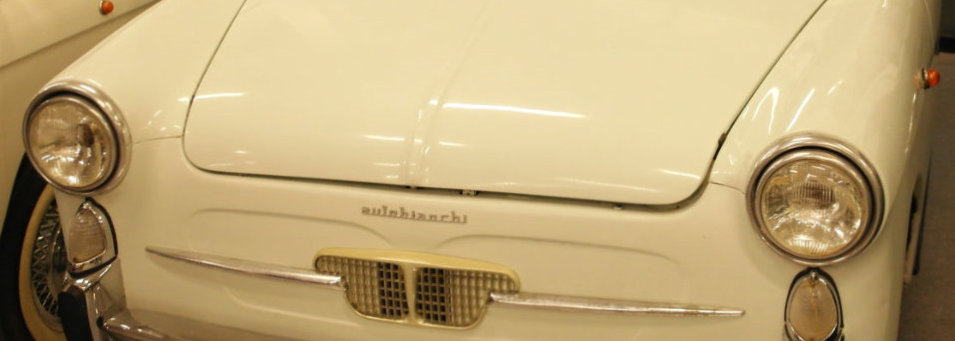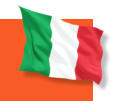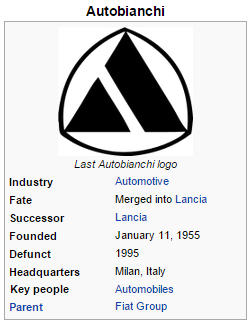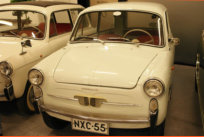




Founded by Edoardo Bianchi in 1885

Autobianchi
Giardinetta Familiare -
1962
Autobianchi was an Italian automobile manufacturer,
created jointly by Bianchi, Pirelli and Fiat in 1955.
Autobianchi produced only a handful of models during its lifetime, which were almost exclusively small cars, with the biggest being the short-lived Autobianchi A111, a small family car. Autobianchis were priced higher than Fiat models of similar size and the brand was used by Fiat to test new and innovative concepts which later found their way into mainstream Fiat vehicles; these concepts included fibreglass bodies and front-wheel drive. The most famous Autobianchi models include the A112 released in 1969, a small hatchback very popular in Italy for racing, and which ceased production in 1986; as well as the Y10, which was the first car to use Fiat's new FIRE (Fully Integrated Robotised Engine). The Primula was the car with which Fiat introduced the particular front-wheel drive arrangement of engine, transmission and differential (final drive) that has become prevalent in its cars today. This car competed with the Innocenti-built Mini, which was the inspiration for the drivetrain layout. Autobianchi was bought by the Fiat group and integrated into the operations of Lancia. The marque survived in Italy until the end of the Y10's production in 1995, but became extinct elsewhere when the model was rebranded as a Lancia in 1989.History
Bianchi, founded by Edoardo Bianchi in 1885 and now remembered primarily as a bicycle manufacturer, was also active in passenger car manufacturer from 1899. Bianchis were in general high-end luxury cars, made with high attention to detail. The company's factory in Abruzzi was destroyed by bombing during World War II. Edoardo Bianchi himself died in 1946 in a car accident, and the ownership of the firm passed to his son, Giuseppe. Even though a new, modern facility was constructed in Desio after the war, economic conditions forced Giuseppe not to resume passenger car production, but rather to focus on bicycles, motorcycles and commercial vehicles. Bianchi bicycles are still manufactured. Bianchi's general manager, Ferruccio Quintavalle, wanted to take advantage of the company's extensive experience in manufacturing cars and ordered the preparation of studies and prototypes of possible new models. Soon it became apparent that resuming passenger car production would not be feasible without a help of stronger partner. Therefore, Bianchi turned to large industrial groups Fiat and Pirelli with a proposal to form a new company to produce automobiles. Thus, the Autobianchi company was born, with the agreement signed by the three parties on 11 January 1955 and share capital of 3 million lira, 33% of which belonged to the Bianchi family. A new, modern, purpose-built plant for the production of Autobianchi cars was erected on an area of 140,000 square metres in Desio. Each of the partners had a clearly defined role and interest in the venture. Fiat was to provide the technical base and components for the assembly of the cars. It was seeking to capture the premium niche of the small car market, at that time occupied by coachbuilders such as Moretti and Vignale, who were building their models on Fiat chassis. Pirelli, which was to supply tires for the cars, sought to expand their OEM market share. Bianchi, was assigned the duties of preparing the bodies and assembling complete vehicles; a step towards their desired return to full passenger car production.Bianchina
The first car to be produced by the new company was the Bianchina, whose name was a tribute to Edoardo Bianchi's first 1899 car. The Bianchina was based on Fiat 500 mechanicals – with its two-cylinder, air cooled engine mounted in the rear – but featured a completely new stylish body designed by Luigi Rapi, who was in charge of Fiat's special body unit and helped to set up production in Desio. With many premium design and equipment features, the Bianchina emerged as an upscale minicar, slotting above the Fiat 500 in the market. Marketed as a "second vehicle in the household", and a luxurious "recreational vehicle", also being targeted at affluent middle- class women, it mirrored the increasing affluence in Italian society. The first Bianchina rolled from the production lines in Desio on September 11, 1957 and had the unusual body style of a two-door landaulet, called "Trasformabile". It remained the sole body style until 1960, when a two-door "Cabriolet" was introduced, followed by a three-door estate version, the "Panoramica" and a two-door saloon, the "Berlina". Finally, two van versions were launched: one resembling a two-seater version of the Panoramica, and another, with a raised and expanded cargo section.
1962
Engine 499 cc 2 cylinders Power 21 HP Top speed 95 km/h Lenght/width 3,18 m/1,32 m Weight 560 kg
Photos mainly by Matti Kreivilä. Historical facts and technical details of the vehicles provided by Wikipedia. Movies YouTube.



- Autobianchi Transformable - 1960
- Autobianchi Familiare - 1962
- Autobianchi Panoramica - 1962
- Autobianchi Cabriolet - 1963
- BMW Isetta 300 - 1956
- BMW Isetta 300 - 1959
- BMW Isetta Standard
- BMW 600 - 1959
- Bond Bug ES 700 - 1973
- Fiat Topolino - 1936
- Fiat Topolino - 1939
- Fiat Topolino - 1951
- Fiat Belvedere - 1952
- Fiat Topolino - 1954
- Fiat 600 - 1955
- Fiat 500 - 1963
- Fiat 500 - 1969
- Fiat Multipla - 1965
- Fuldamobil 4-wheel - 1958
- Fuldamobil King S7 - 1959
- GLAS Isar T700 - 1962
- Goggomobil T400 - 1959
- Goggomobil T250 - 1961
- Goggomobil T250 - 1969
- Goggomobil Coupe
- Heinkel Kabine - 1959
- Honda N600 - 1970
- Jalta Saporoshez - 1967
- Lloyd Alexander TS - 1960
- Messerschmitt KR200 - 1960
- Messerschmitt KR201
- Messerschmitt KR200 - 1963
- Messerschmitt KR200 - 1964
- NSU Prinz I - 1958
- Scootacar Mk3 - 1963
- Steyr-Puch 500 -1961
- Steyr-Puch 650 - 1964
- Trabant P 50 - 1961
- Trojan 603/198 - 1964
- Trojan 3-wheeler - 1964
- Trojan 3-wheeler - 1964
- Vespa 400 - 1959
- Victoria Spatz 250 - 1957
- ZŁndapp Janus - 1959


- About Scooters
- Apollo moped
- Cezeta 175 - 1960
- Heinkel Tourist - 1960
- Lambretta 125 - 1953
- Puch SR 150 - 1958
- Pyrkijš moped
- Suzuki Burgman 400
- Tunturi City - 1980
- Vespa 150 - 1959
- Yamaha Passola 50 - 1980
- ZŁndapp Bella w. sidecar - 1960
- ZŁndapp Bella 204 - 1960
- ZŁndapp Bella 200 Deluxe - 1963
- ZŁndapp Combinette




















